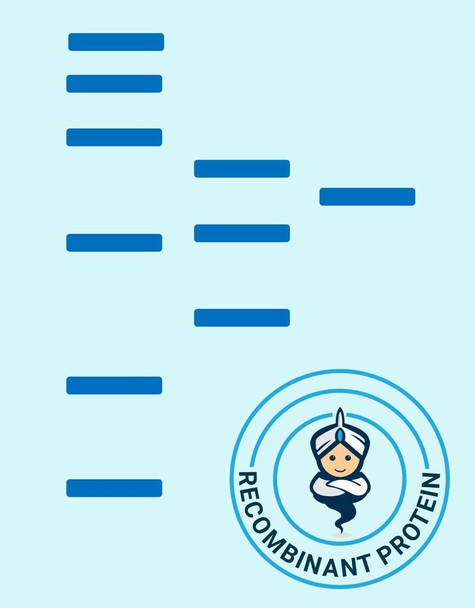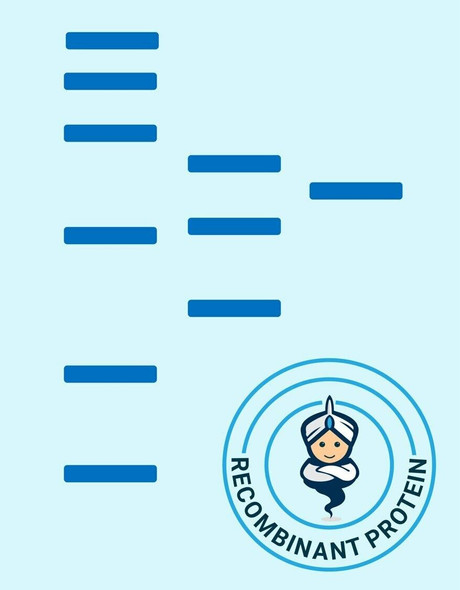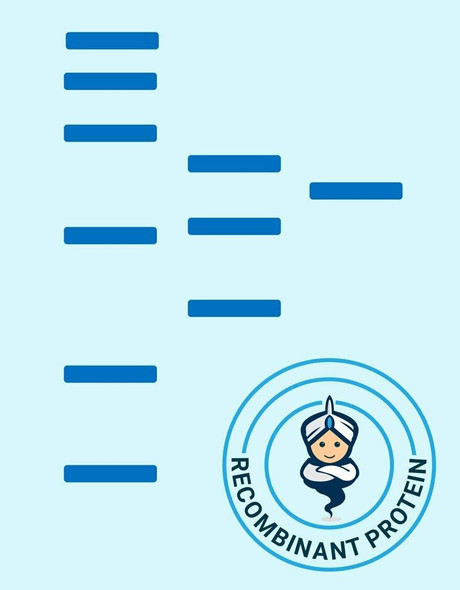Human BACE1 Recombinant Protein (RPPB1433)
- SKU:
- RPPB1433
- Product type:
- Recombinant Protein
- Size:
- 50ug
- Species:
- Human
- Target:
- BACE1
- Synonyms:
- Beta-Secretase
- Membrane-Associated Aspartic Protease
- Beta-Site APP Cleaving Enzyme
- Beta-Site APP-Cleaving Enzyme
- Source:
- Sf9 Insect cells
- Uniprot:
- P56817
Description
| Product Name: | Human BACE1 Recombinant Protein |
| Product Code: | RPPB1433 |
| Size: | 50µg |
| Species: | Human |
| Target: | BACE1 |
| Synonyms: | Beta-Secretase, Membrane-Associated Aspartic Protease, Beta-Site APP Cleaving Enzyme, Beta-Site APP-Cleaving Enzyme, Aspartyl Protease, EC 3.4.23.46, Memapsin-2, Asp, BACE, ASP2, Beta-Site Amyloid Beta A4 Precursor Protein-Cleaving Enzyme, Beta-Site Amyloid Precursor Protein Cleaving Enzyme, Transmembrane Aspartic Proteinase Asp2, Beta-Secretase 1 Precursor Variant, Beta-Site APP-Cleaving Enzyme, APP Beta-Secretase, EC 3.4.23, KIAA1149, HSPC104. |
| Source: | Sf9 Insect cells |
| Physical Appearance: | Sterile Filtered colorless solution. |
| Formulation: | BACE1 protein solution containing Phosphate-Buffered Saline (pH 7.4) containing 10% glycerol. |
| Stability: | Store at 4°C if entire vial will be used within 2-4 weeks. Store, frozen at -20°C for longer periods of time. For long term storage it is recommended to add a carrier protein (0.1% HSA or BSA).Avoid multiple freeze-thaw cycles. |
| Purity: | Greaterthan 90.0% as determined by SDS-PAGE. |
| Amino Acid Sequence: | TQHGIRLPLR SGLGGAPLGL RLPRETDEEP EEPGRRGSFV EMVDNLRGKS GQGYYVEMTV GSPPQTLNIL VDTGSSNFAV GAAPHPFLHR YYQRQLSSTY RDLRKGVYVP YTQGKWEGEL GTDLVSIPHG PNVTVRANIA AITESDKFFI NGSNWEGILG LAYAEIARPD DSLEPFFDSL VKQTHVPNLF SLQLCGAGFP LNQSEVLASV GGSMIIGGID HSLYTGSLWY TPIRREWYYE VIIVRVEING QDLKMDCKEY NYDKSIVDSG TTNLRLPKKV FEAAVKSIKA ASSTEKFPDG FWLGEQLVCW QAGTTPWNIF PVISLYLMGE VTNQSFRITI LPQQYLRPVE DVATSQDDCY KFAISQSSTG TVMGAVIMEG FYVVFDRARK RIGFAVSACH VHDEFRTAAV EGPFVTLDME DCGYNIPQTD ESTLMTHHHH HH |
| Biological Activity: | Specific activity is > 5 pmol/min/ug in which one unit will convert 1.0 pmole of Mca-SEVNLDAEFRK(Dnp)RR-NH2 to MCA- Pro-Leu-OH per minute at pH 3.5 at 25C. |
Beta-secretase 1 or BACE1 or beta-site amyloid precursor protein cleaving enzyme 1, is a protein that is encoded by the BACE1 gene in humans. Expression of BACE1 is seen primarily in neurons as it is crucial for the creation of myelin sheats in the peripheric nervous system. Beta-secretase 1 is a proteas that is located in the cell membrane (transmembrane). The enzyme consists of 2 active sites (aspartate residues) in the extracellular domain that can act as a dimer.
BACE1 Human produced in Sf9 Baculovirus cells is a single, glycosylated polypeptide chain containing 442 amino acids (22-457 a.a.) and having a molecular mass of 49.2kDa. BACE1 is expressed with a 6 amino acid His tag at C-Terminus and purified by proprietary chromatographic techniques.
| UniProt Protein Function: | BACE: an integral membrane glycoprotein and aspartic protease that is found mainly in the Golgi. Cleaves APP at the amino terminus of the A-beta peptide sequence, leading to the generation and extracellular release of beta-cleaved soluble APP, and a corresponding cell-associated carboxy-terminal fragment which is later release by gamma-secretase. Four splice-variant isoforms have been described. |
| UniProt Protein Details: | Protein type:EC 3.4.23.46; Membrane protein, integral; Protease Chromosomal Location of Human Ortholog: 11q23.2-q23.3 Cellular Component: endoplasmic reticulum lumen; endosome; endosome membrane; Golgi apparatus; integral to plasma membrane; late endosome; multivesicular body; plasma membrane; trans-Golgi network Molecular Function:aspartic-type endopeptidase activity; beta-amyloid binding; beta-aspartyl-peptidase activity; enzyme binding; peptidase activity; protein binding Biological Process: beta-amyloid metabolic process; cellular protein metabolic process; membrane protein ectodomain proteolysis; protein catabolic process; proteolysis |
| NCBI Summary: | This gene encodes a member of the peptidase A1 family of aspartic proteases. Alternative splicing results in multiple transcript variants, at least one of which encodes a preproprotein that is proteolytically processed to generate the mature protease. This transmembrane protease catalyzes the first step in the formation of amyloid beta peptide from amyloid precursor protein. Amyloid beta peptides are the main constituent of amyloid beta plaques, which accumulate in the brains of human Alzheimer's disease patients. [provided by RefSeq, Nov 2015] |
| UniProt Code: | P56817 |
| NCBI GenInfo Identifier: | 296434407 |
| NCBI Gene ID: | 23621 |
| NCBI Accession: | P56817.2 |
| UniProt Secondary Accession: | P56817,Q9BYB9, Q9BYC0, Q9BYC1, Q9UJT5, Q9ULS1, A0M8W7 B0YIU9, E9PE65, H7BXJ9, |
| UniProt Related Accession: | P56817 |
| Molecular Weight: | 42,107 Da |
| NCBI Full Name: | Beta-secretase 1 |
| NCBI Synonym Full Names: | beta-secretase 1 |
| NCBI Official Symbol: | BACE1 |
| NCBI Official Synonym Symbols: | ASP2; BACE; HSPC104 |
| NCBI Protein Information: | beta-secretase 1 |
| UniProt Protein Name: | Beta-secretase 1 |
| UniProt Synonym Protein Names: | Aspartyl protease 2; ASP2; Asp 2; Beta-site amyloid precursor protein cleaving enzyme 1; Beta-site APP cleaving enzyme 1; Memapsin-2; Membrane-associated aspartic protease 2 |
| Protein Family: | Beta-secretase |
| UniProt Gene Name: | BACE1 |
| UniProt Entry Name: | BACE1_HUMAN |










